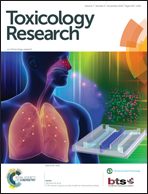Is tartrazine really safe? In silico and ex vivo toxicological studies in human leukocytes: a question of dose
Abstract
The use of food colorings has a long-recorded history. Tartrazine (TRZ) is a dye that confers a lemon-yellow color to food and is widely used in the manufacture of numerous food products, as well as in pharmaceuticals and cosmetics. However, few studies have addressed the toxicology of TRZ in human cells or tissues. Considering the frequent consumption of the TRZ dye in food products and the lack of toxicological data, the present study aimed to evaluate the cytotoxicity and genotoxicity of the TRZ dye in human leukocyte cultures and perform theoretical studies to predict its toxicity in silico. Leukocyte cultures were treated with TRZ at concentrations of 5, 17.5, 35, 70, 100, 200, 300, 400, and 500 μg mL−1. All groups were assayed in triplicates. The mutagenicity was evaluated using the micronucleus test, the nuclear division index, and the nuclear division cytotoxicity index, and the chromosomal instability was quantitatively evaluated by band cytogenetics. Genotoxicity was evaluated using the alkaline comet test. Viability was assessed using the Trypan Blue method. Statistical analyses were performed using analysis of variance followed by Tukey's post hoc test, with a p value <0.05 reflecting statistical significance. No mutagenicity or cytotoxicity was found for the dye at the concentrations evaluated. However, DNA damage was induced by TRZ at a concentration of 70 μg mL−1. These results were confirmed by the predictive data from the in silico evaluations. Further studies are required to confirm our data, considering the frequency of the use of TRZ in the diet of the population, including that of children, as well as the exposure to TRZ through drugs, cosmetics, and other non-food products.



 Please wait while we load your content...
Please wait while we load your content...